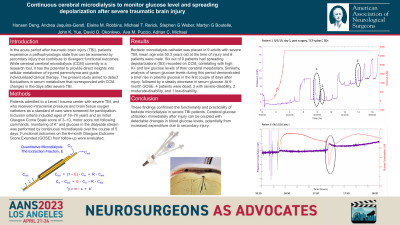Continuous cerebral microdialysis to monitor glucose level and spreading depolarization after severe traumatic brain injury
Continuous Cerebral Microdialysis to Monitor Glucose Level and Spreading Depolarization After Severe Traumatic Brain Injury
Friday, April 21, 2023


Hansen Deng, MD
Resident Physician
University of Pittsburgh School of Medicine
Pittsburgh, Pennsylvania, United States
ePoster Presenter(s)
Introduction: In the acute period after traumatic brain injury (TBI), patients experience a pathophysiologic state that can be worsened by secondary injury that contribute to divergent functional outcomes. While cerebral cerebral microdialysis (CCM) currently is a research tool, it has the potential to provide direct insights into cellular metabolism of injured parenchyma and guide individualized clinical therapy. The present study aimed to detect fluctuations in serum metabolism that corresponded with CCM changes in the days after severe TBI.
Methods: Patients admitted to a Level I trauma center with severe TBI, and who received intracranial pressure and brain tissue oxygen catheters as a standard of care were screened for participation. Inclusion criteria included ages of 18–70 years and an initial Glasgow Coma Scale score of 3–10, motor score not following commands. monitoring of K+ and glucose in the dialysate stream was performed by continuous microdialysis over the course of 5 days. Functional outcomes on the 6-month Glasgow Outcome Score Extended (GOSE) from follow-up were evaluated.
Results: Bedside microdialysis catheter was placed in 9 adults with severe TBI, mean age was 50.3 years old at the time of injury and 6 patients were male. Six out of 9 patients had spreading depolarizations (SD) recorded on CCM, correlating with high K+ and low glucose levels of their cerebral metabolism. Similarly, analysis of serum glucose levels during this period demonstrated a brief rise in plasma glucose in the first couple of days after injury, followed by a steady decrease in serum glucose. At 6-month GOSE, 4 patients were dead, 2 with severe-disability, 2 moderate-disability, and 1 low-disability.
Conclusion : These findings confirmed the functionality and practicality of bedside microdialysis in severe TBI patients. Cerebral glucose utilization immediately after injury can be coupled with detectable changes in blood glucose levels, potentially from increased expenditure due to secondary injury.
Methods: Patients admitted to a Level I trauma center with severe TBI, and who received intracranial pressure and brain tissue oxygen catheters as a standard of care were screened for participation. Inclusion criteria included ages of 18–70 years and an initial Glasgow Coma Scale score of 3–10, motor score not following commands. monitoring of K+ and glucose in the dialysate stream was performed by continuous microdialysis over the course of 5 days. Functional outcomes on the 6-month Glasgow Outcome Score Extended (GOSE) from follow-up were evaluated.
Results: Bedside microdialysis catheter was placed in 9 adults with severe TBI, mean age was 50.3 years old at the time of injury and 6 patients were male. Six out of 9 patients had spreading depolarizations (SD) recorded on CCM, correlating with high K+ and low glucose levels of their cerebral metabolism. Similarly, analysis of serum glucose levels during this period demonstrated a brief rise in plasma glucose in the first couple of days after injury, followed by a steady decrease in serum glucose. At 6-month GOSE, 4 patients were dead, 2 with severe-disability, 2 moderate-disability, and 1 low-disability.
Conclusion : These findings confirmed the functionality and practicality of bedside microdialysis in severe TBI patients. Cerebral glucose utilization immediately after injury can be coupled with detectable changes in blood glucose levels, potentially from increased expenditure due to secondary injury.
